Novels Vs. Short Stories – 5 Clear Differences
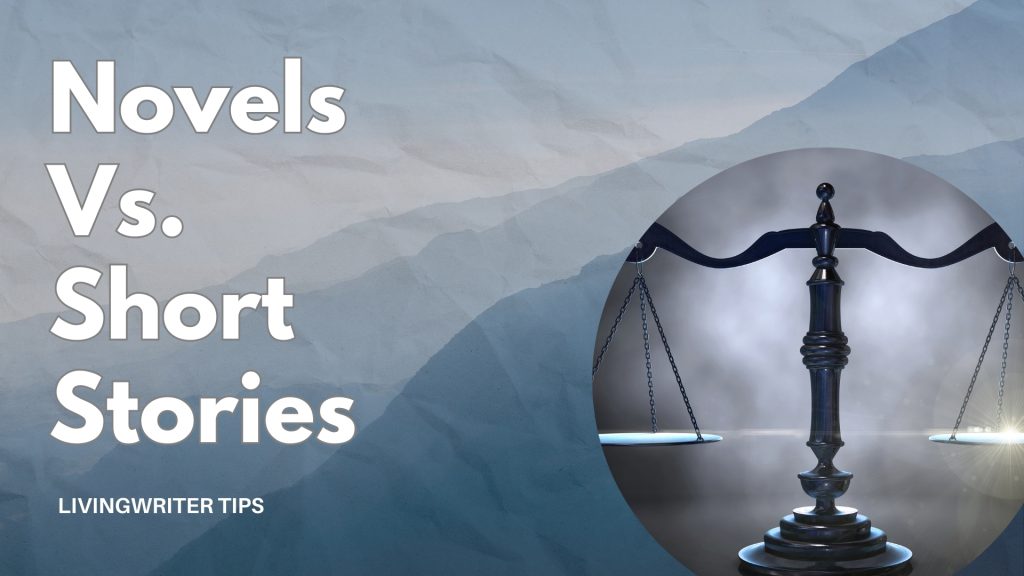
Novels and short stories are very different mediums, even though people may not think so. And it’s interesting because being good at one doesn’t automatically mean you can do the other. Today, I’ll be discussing the differences & similarities between short stories and novels. As well as how they affect the writing process.
Of course, short stories have fewer words than novels—that’s the obvious difference. However, having less time to tell the story changes the plot structure, pacing, ending, and overall style of the story. And these are all things you’ll need to be conscious of when writing.
Below, you’ll find the five major differences between novels and short stories. I’ll break each category down in a digestible way to paint a clear picture of novels vs. short stories once and for all. Regardless of which medium you currently write, you’ll have the tools to pivot to the other. So, without further ado, let’s get into everything you need to know about novels vs. short stories.
Table of Contents
Novels Vs. Short Stories
Novels and short stories simply don’t write the same way, and you probably naturally find it easier to write one or the other. This is because there are many differences between the two that go far beyond the overall word count. Condensing a novel doesn’t make a short story, and stretching a short story doesn’t make it a novel.
That said, many key factors do tie in with how long you’ve got to tell your story. Here are the five things you need to consider when sitting down to write in either the short story or novel category.
5. Word Count
Ok, so I said there were differences between the two besides word count, and there are. That said, we’ve still got to talk about overall length. As I mentioned above, trimming your novel way down or adding a ton to your short story doesn’t work.
So, while these word counts are something you should be aware of, there are several other impactful things beyond word count. How long should a short or a novel story be? I’m glad you asked.
How Long Should A Short Story Be
Short stories are typically between 1000 to 7500 words. Sure, it’s possible to have a 9000-word short story, but 1k to 7.5k is the most common.
How Long Should A Novel Be
Novels usually have 50,000 words or more, but the exact length varies by genre. For example, fantasy novels can go much longer than, say, horror novels typically do.
Key Takeaways
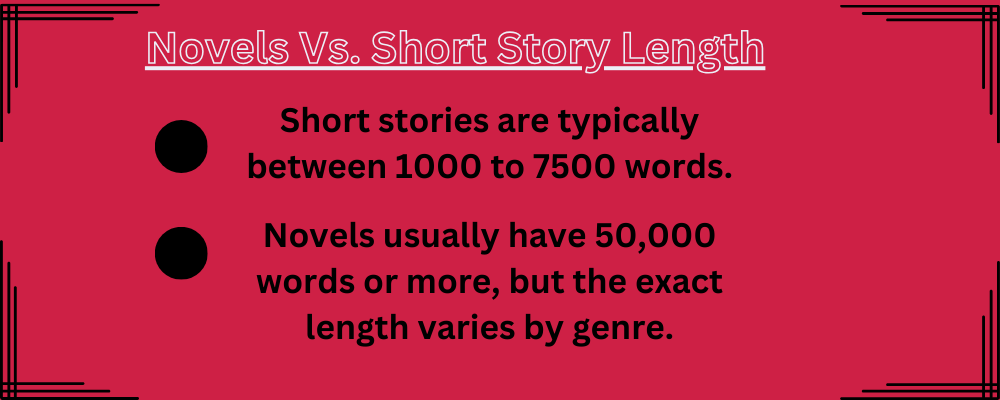
4. Plot structure
The plot structure for your story will be very similar at a basic level – There will be a beginning, a middle, and an end, regardless of whether it’s a short story or a novel. The difference in plot structure is how they are balanced.
How Is A Novel Structured
Novels, in general, are like films and have three acts: Act 1, which is about 25% of the story; Act 2, which is 50%; and Act 3, which is the remaining 25%. These numbers are pretty standard, and authors with well-structured plots will be pretty close to them.
For a deep dive into the three-act structure, click here: Screenplay Structure: Tips to Engage Audiences
How Is A Short Stort Structured
Short stories are less structured, so there isn’t a hard and fast rule. For example, the 1st act of a short story could be a few chapters, and most of the story could be 2nd act before getting to an abrupt end. You’ve got a lot of freedom as a writer here.
That said, I do have some small guidance to offer with the 7-step short story structure. Regardless of how much story you spend on each part, this will help make sure you’ve got everything present and accounted for. Here are the steps:
- Person: Introduce a character
- Place: Introduce a place
- Problem: Someone has a problem
- Attempt to solve it: They attempt to solve the problem
- Fail: They don’t succeed
- Try again and fail again: They try again and fail
- Try and get a resolution: Trying again, they succeed or fail
Regardless of how long each of these steps takes, you’ll want to make sure they’re all covered within your story. You have more liberty with the structure because the story is much shorter. If your story is 5000 words and most of that is “second act,” that’s only around 3500 words.
In a novel, having an act 2 that is 75% of the overall story would put your reader in that section for around 37,000 or more, which will be a tough sell, to say the least.
Key Takeaways
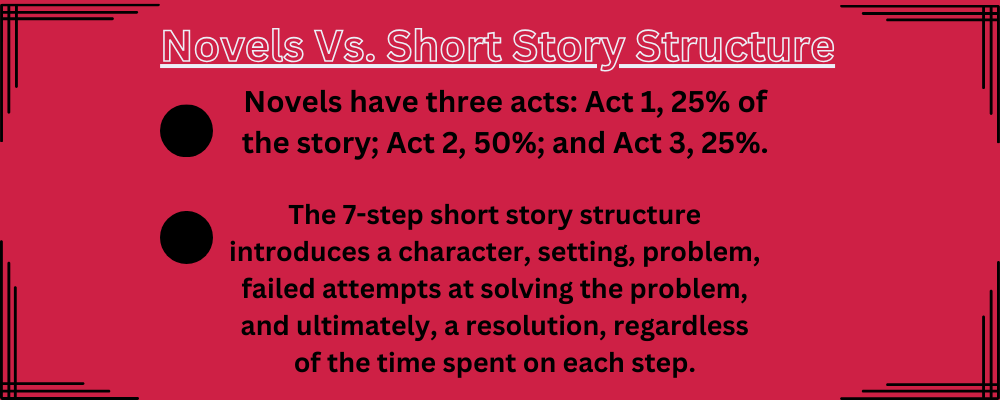
3. Pacing
With such a drastic difference in length between novels and short stories, the pacing is also different. Novels have rising and falling sections. Peaks and valleys. The story ramps up in intensity and then has sections that let the reader breathe. This helps to maintain interest throughout without overloading readers.
You May Also Like: Mastering Pacing In Novels And Screenplays
Short stories, on the other hand, don’t have these same peaks and valleys. Instead, they usually have one of two styles—a steady, even pace from start to finish or a plot with a constant rise. You can get away with peaks and valleys, but it’s harder and often unnecessary. With a lower word count, readers don’t need nearly as much respite from the tension.
This is also a good time to mention that short stories have only a single plot. In novels, subplots are a must. In short stories, you’ll really only have time to resolve one plot. So, keep that in mind, especially if you’re coming from a novel background and into short stories.
Key Takeaways
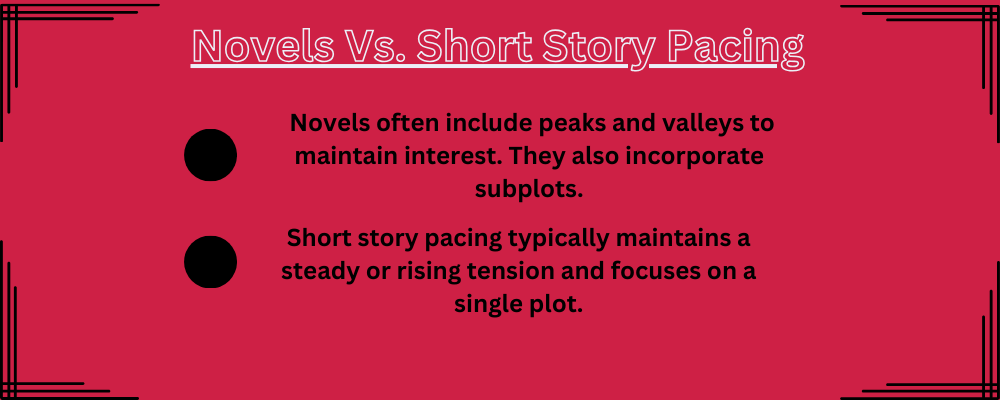
2. Endings
Novels almost always have clear endings and a denouement. A denouement follows the resolution and shows how the characters and world have changed. This ties up loose ends, provides closure, and reveals the ultimate consequences of the story’s events.
Short stories can be much more open-ended. Sometimes, they’ll even end right as a character is about to make a choice and let the readers think of what may happen. That said, even if your ending is open to interpretation, your character should still evolve in some perceptible way.
Key Takeaways
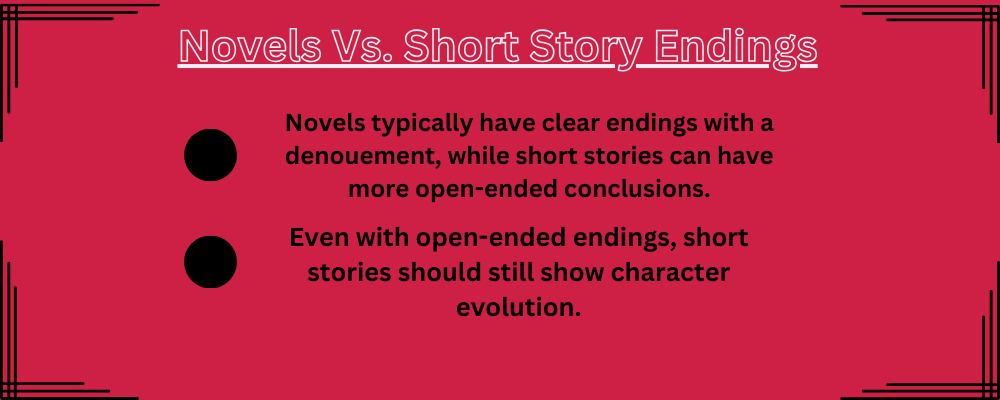
1. Style
The last major difference between novels and short stories is the ability to play with language and be experimental. With short stories, you have options to be flashy, and it works well cause they’re shorter. If you try something that ends up being challenging in some way, a novel tends to punish you more.
The same thing goes for characters. In novels, the characters have to be a bit more engaging. After all, readers will be with them for a long time, and the conflict and how engaged they are in the plot have much to do with entertaining characters.
Short stories can use some bad characters without many (or any) redeeming qualities as long as they’re justified by the plot. Have you ever heard someone say, “I can only handle *insert person* in small doses!” This is essentially why unlikeable characters work in short stories, cause it’s a relatively short ride.
Key Takeaways
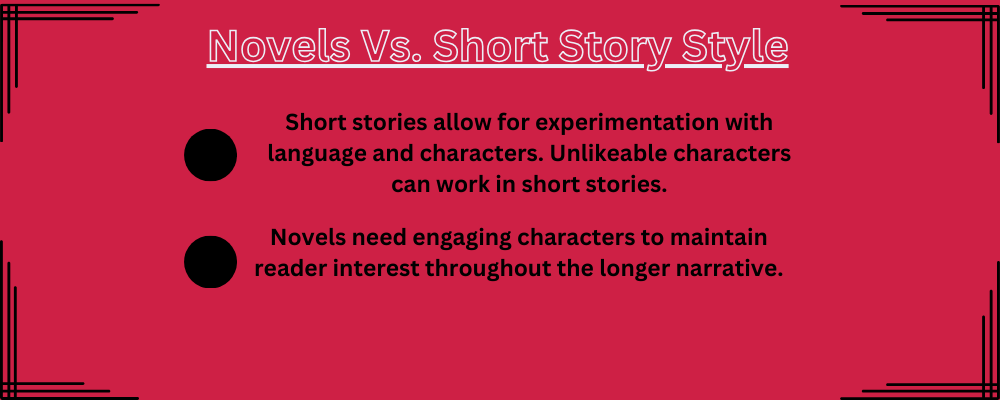
Writing With LivingWriter
Regardless of which medium you write, short stories or full-length novels, you’ll need somewhere to write your work. Let me introduce you to LivingWriter. Voted the #1 Best App For Writing (check out the independent reviews), LivingWriter helps you reach your full writing potential.
It solves many of the hardships that writers face with a user-friendly interface and a plethora of valuable features:
- Organized Writing Space:
- Manuscripts are divided into plot points, chapters, and character sections, with customizable status options and color coding for easy navigation.
- Note-taking and Brainstorming Tools:
- Includes global notes, standard and free-form plotting grids, mind maps, timelines, plots, and family trees.
- AI Tools:
- Cutting-edge AI features like outline generation, AI rewrite, tone analysis, and character art images.
- Research Boards:
- Store reference articles, images, and notes for easy access and organization.
- Innovative Manuscripts:
- A simple, familiar writing space with no learning curve offers everything a traditional word processor does.
- Story Outline Templates:
- Choose from various templates when starting a manuscript.
- Easy Exporting:
- Export to PDFs, DOCX files, Google Drive, Dropbox, and Amazon Manuscript format for KDP. Include elements, notes, and a table of contents.
- Smart Elements:
- Intuitively links element names in the manuscript to descriptions, nicknames, relationships, and pictures.
- Real-Time Feedback and Collaboration:
- Collaborate with others and receive real-time feedback on your manuscript.
Conclusion
If you’ve made it this far, you know all the important distinctions between short stories and novels. If you can be conscious of your structure, pacing, style, and ending, you should be able to bet better at pivoting from short stories to novels or vice-versa. Now, the only thing left is to get out there and write. So, until next time, take care.